1998 OPEL FRONTERA ignition
[x] Cancel search: ignitionPage 2055 of 6000
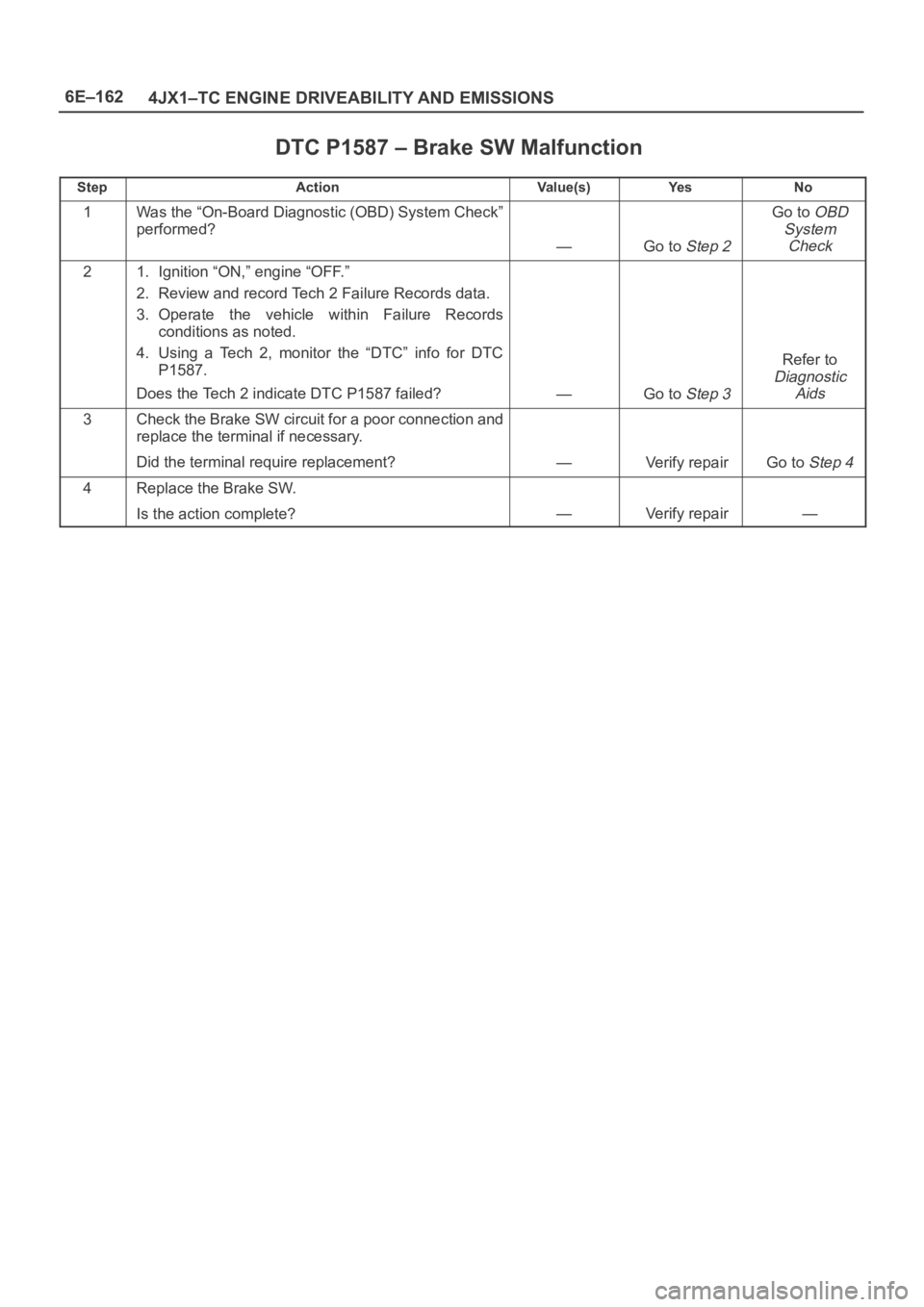
6E–162
4JX1–TC ENGINE DRIVEABILITY AND EMISSIONS
DTC P1587 – Brake SW Malfunction
StepActionVa l u e ( s )Ye sNo
1Was the “On-Board Diagnostic (OBD) System Check”
performed?
—Go to Step 2
Go to OBD
System
Check
21. Ignition “ON,” engine “OFF.”
2. Review and record Tech 2 Failure Records data.
3. Operate the vehicle within Failure Records
conditions as noted.
4. Using a Tech 2, monitor the “DTC” info for DTC
P1587.
Does the Tech 2 indicate DTC P1587 failed?
—Go to Step 3
Refer to
Diagnostic
Aids
3Check the Brake SW circuit for a poor connection and
replace the terminal if necessary.
Did the terminal require replacement?
—Verify repairGo to Step 4
4Replace the Brake SW.
Is the action complete?
—Verify repair—
Page 2057 of 6000
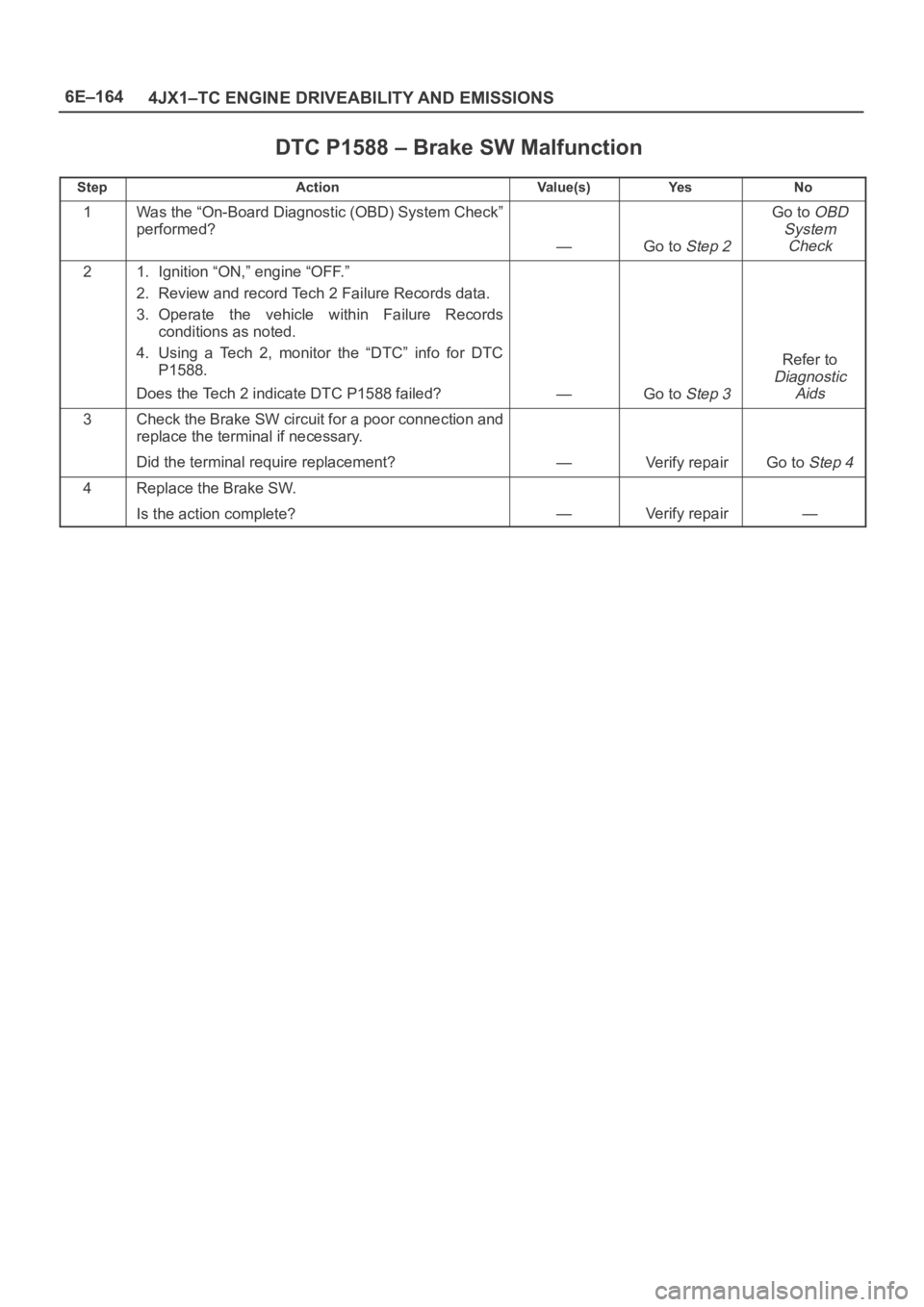
6E–164
4JX1–TC ENGINE DRIVEABILITY AND EMISSIONS
DTC P1588 – Brake SW Malfunction
StepActionVa l u e ( s )Ye sNo
1Was the “On-Board Diagnostic (OBD) System Check”
performed?
—Go to Step 2
Go to OBD
System
Check
21. Ignition “ON,” engine “OFF.”
2. Review and record Tech 2 Failure Records data.
3. Operate the vehicle within Failure Records
conditions as noted.
4. Using a Tech 2, monitor the “DTC” info for DTC
P1588.
Does the Tech 2 indicate DTC P1588 failed?
—Go to Step 3
Refer to
Diagnostic
Aids
3Check the Brake SW circuit for a poor connection and
replace the terminal if necessary.
Did the terminal require replacement?
—Verify repairGo to Step 4
4Replace the Brake SW.
Is the action complete?
—Verify repair—
Page 2060 of 6000
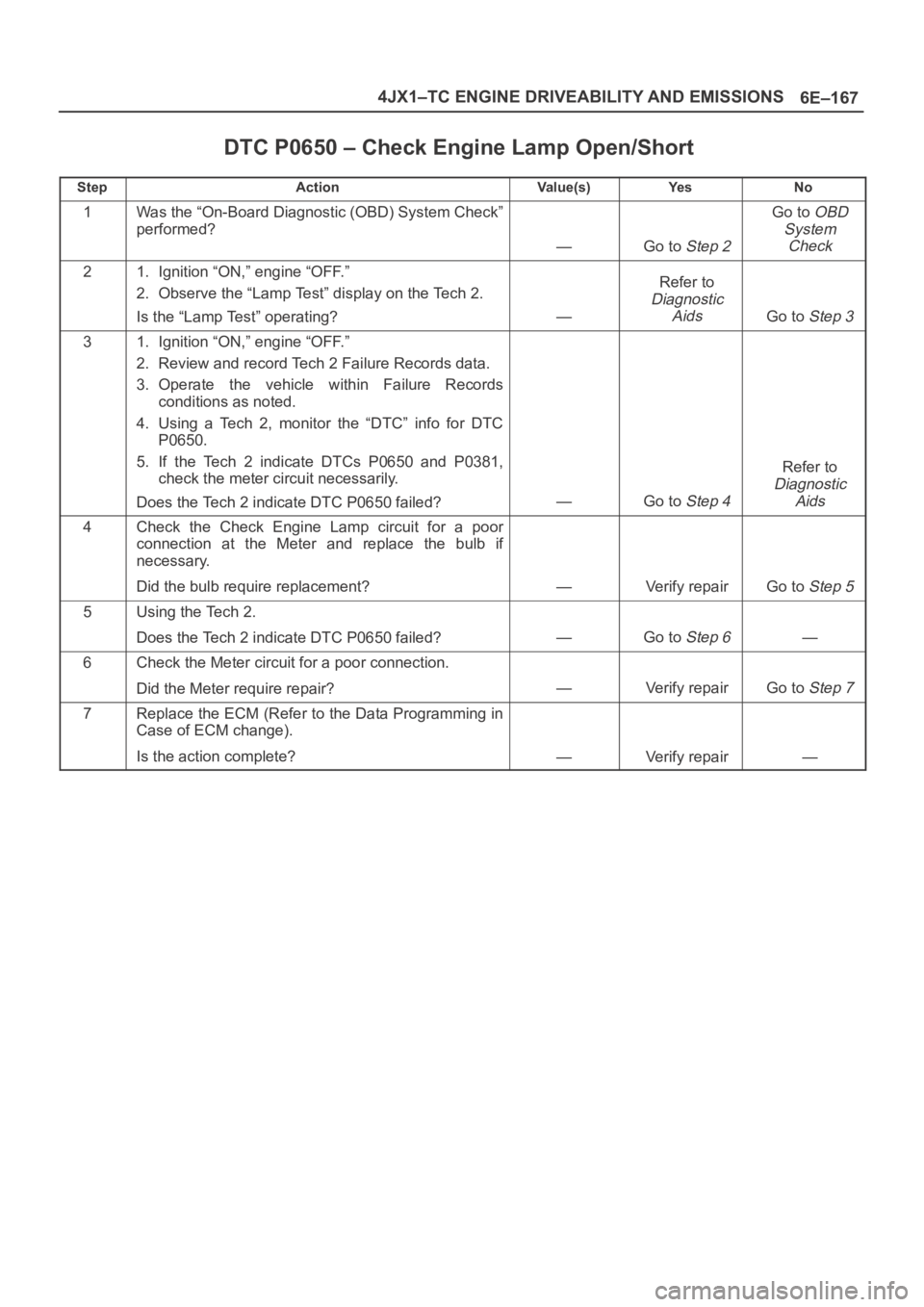
6E–167 4JX1–TC ENGINE DRIVEABILITY AND EMISSIONS
DTC P0650 – Check Engine Lamp Open/Short
StepActionVa l u e ( s )Ye sNo
1Was the “On-Board Diagnostic (OBD) System Check”
performed?
—Go to Step 2
Go to OBD
System
Check
21. Ignition “ON,” engine “OFF.”
2. Observe the “Lamp Test” display on the Tech 2.
Is the “Lamp Test” operating?
—
Refer to
Diagnostic
Aids
Go to Step 3
31. Ignition “ON,” engine “OFF.”
2. Review and record Tech 2 Failure Records data.
3. Operate the vehicle within Failure Records
conditions as noted.
4. Using a Tech 2, monitor the “DTC” info for DTC
P0650.
5. If the Tech 2 indicate DTCs P0650 and P0381,
check the meter circuit necessarily.
Does the Tech 2 indicate DTC P0650 failed?
—Go to Step 4
Refer to
Diagnostic
Aids
4Check the Check Engine Lamp circuit for a poor
connection at the Meter and replace the bulb if
necessary.
Did the bulb require replacement?
—Verify repairGo to Step 5
5Using the Tech 2.
Does the Tech 2 indicate DTC P0650 failed?
—Go to Step 6—
6Check the Meter circuit for a poor connection.
Did the Meter require repair?
—Verify repairGo to Step 7
7Replace the ECM (Refer to the Data Programming in
Case of ECM change).
Is the action complete?
—Verify repair—
Page 2062 of 6000
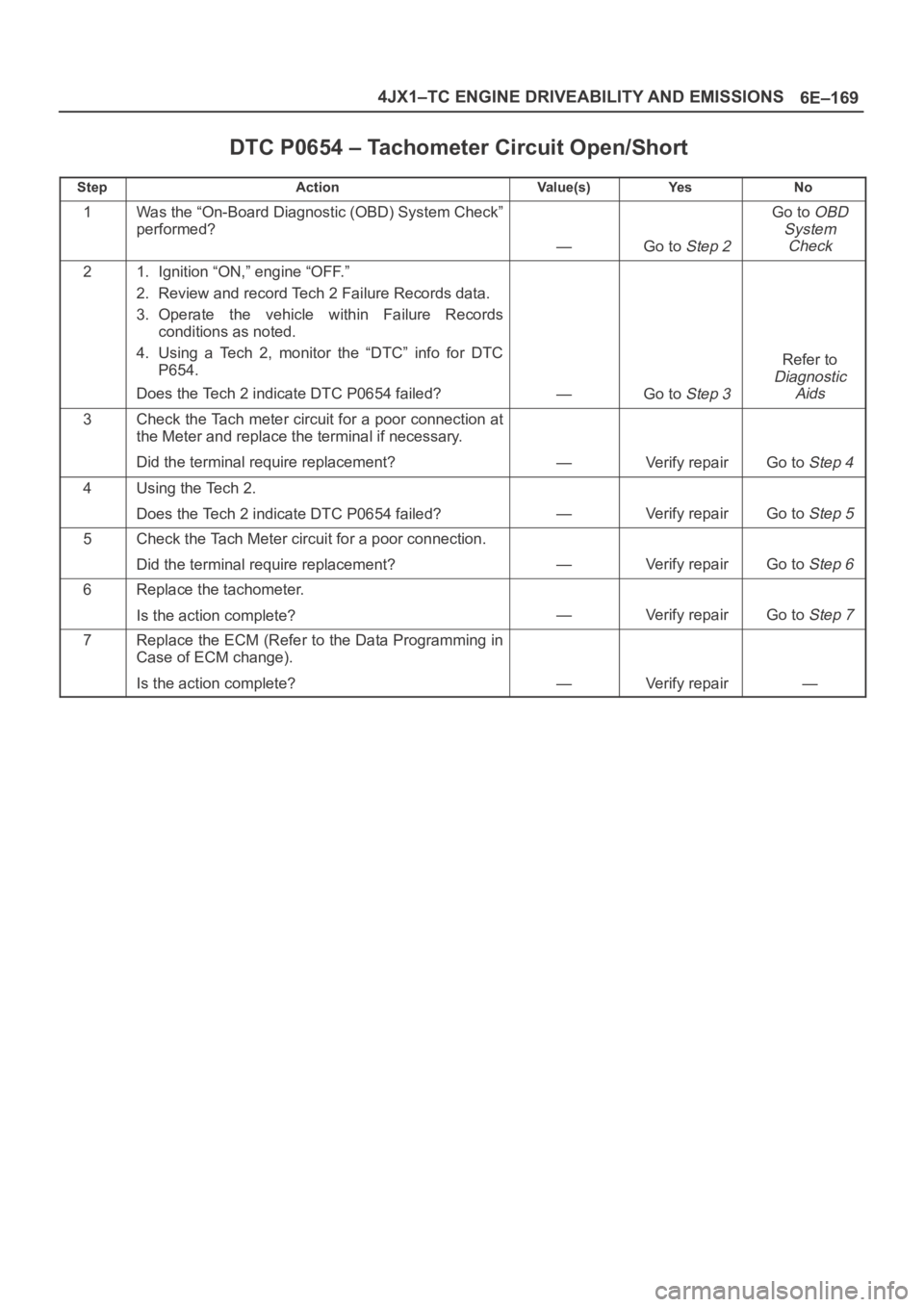
6E–169 4JX1–TC ENGINE DRIVEABILITY AND EMISSIONS
DTC P0654 – Tachometer Circuit Open/Short
StepActionVa l u e ( s )Ye sNo
1Was the “On-Board Diagnostic (OBD) System Check”
performed?
—Go to Step 2
Go to OBD
System
Check
21. Ignition “ON,” engine “OFF.”
2. Review and record Tech 2 Failure Records data.
3. Operate the vehicle within Failure Records
conditions as noted.
4. Using a Tech 2, monitor the “DTC” info for DTC
P654.
Does the Tech 2 indicate DTC P0654 failed?
—Go to Step 3
Refer to
Diagnostic
Aids
3Check the Tach meter circuit for a poor connection at
the Meter and replace the terminal if necessary.
Did the terminal require replacement?
—Verify repairGo to Step 4
4Using the Tech 2.
Does the Tech 2 indicate DTC P0654 failed?
—Verify repairGo to Step 5
5Check the Tach Meter circuit for a poor connection.
Did the terminal require replacement?
—Verify repairGo to Step 6
6Replace the tachometer.
Is the action complete?
—Verify repairGo to Step 7
7Replace the ECM (Refer to the Data Programming in
Case of ECM change).
Is the action complete?
—Verify repair—
Page 2064 of 6000
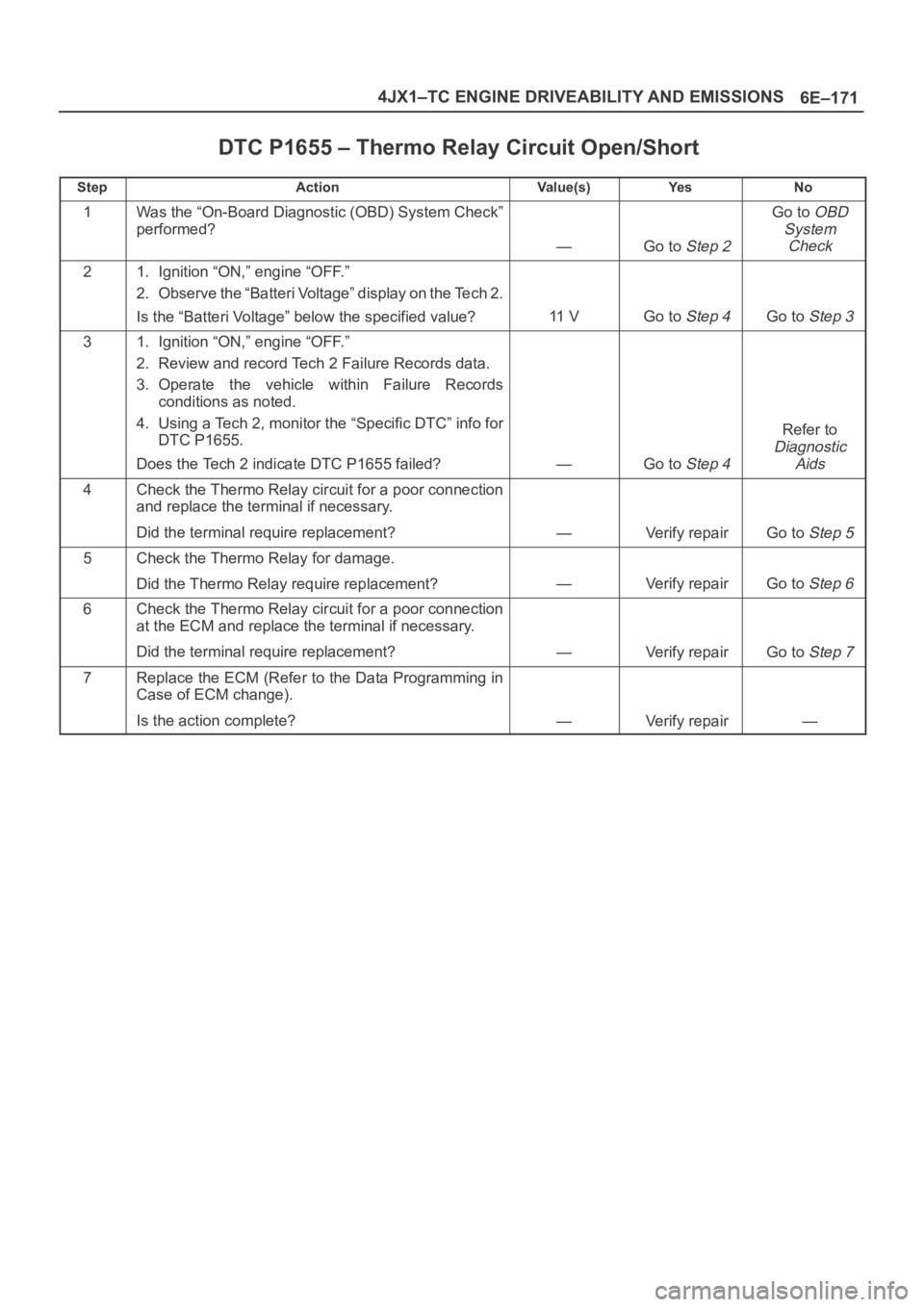
6E–171 4JX1–TC ENGINE DRIVEABILITY AND EMISSIONS
DTC P1655 – Thermo Relay Circuit Open/Short
StepActionVa l u e ( s )Ye sNo
1Was the “On-Board Diagnostic (OBD) System Check”
performed?
—Go to Step 2
Go to OBD
System
Check
21. Ignition “ON,” engine “OFF.”
2. Observe the “Batteri Voltage” display on the Tech 2.
Is the “Batteri Voltage” below the specified value?
11 VGo to Step 4Go to Step 3
31. Ignition “ON,” engine “OFF.”
2. Review and record Tech 2 Failure Records data.
3. Operate the vehicle within Failure Records
conditions as noted.
4. Using a Tech 2, monitor the “Specific DTC” info for
DTC P1655.
Does the Tech 2 indicate DTC P1655 failed?
—Go to Step 4
Refer to
Diagnostic
Aids
4Check the Thermo Relay circuit for a poor connection
and replace the terminal if necessary.
Did the terminal require replacement?
—Verify repairGo to Step 5
5Check the Thermo Relay for damage.
Did the Thermo Relay require replacement?
—Verify repairGo to Step 6
6Check the Thermo Relay circuit for a poor connection
at the ECM and replace the terminal if necessary.
Did the terminal require replacement?
—Verify repairGo to Step 7
7Replace the ECM (Refer to the Data Programming in
Case of ECM change).
Is the action complete?
—Verify repair—
Page 2066 of 6000
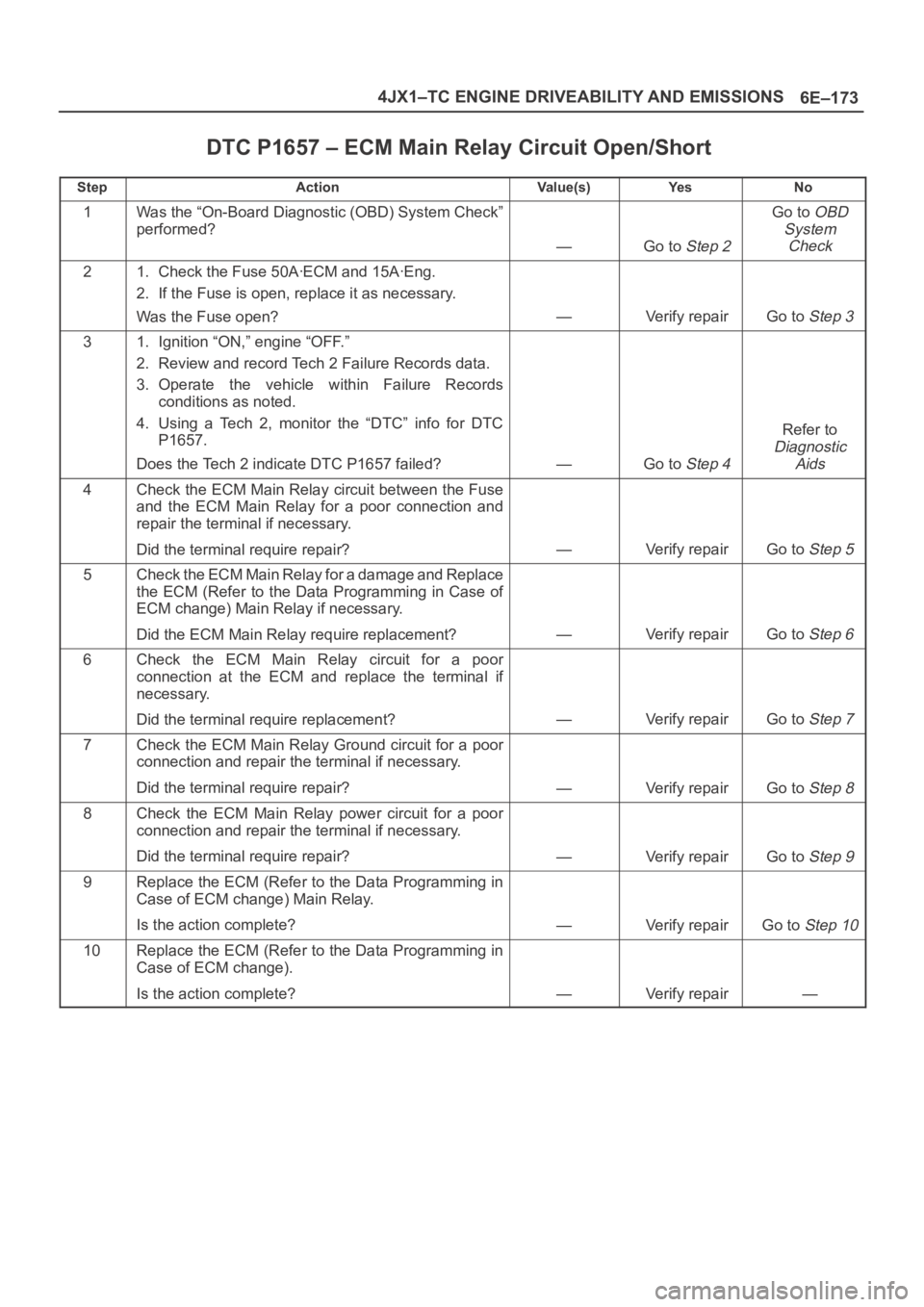
6E–173 4JX1–TC ENGINE DRIVEABILITY AND EMISSIONS
DTC P1657 – ECM Main Relay Circuit Open/Short
StepActionVa l u e ( s )Ye sNo
1Was the “On-Board Diagnostic (OBD) System Check”
performed?
—Go to Step 2
Go to OBD
System
Check
21. Check the Fuse 50AꞏECM and 15AꞏEng.
2. If the Fuse is open, replace it as necessary.
Was the Fuse open?
—Verify repairGo to Step 3
31. Ignition “ON,” engine “OFF.”
2. Review and record Tech 2 Failure Records data.
3. Operate the vehicle within Failure Records
conditions as noted.
4. Using a Tech 2, monitor the “DTC” info for DTC
P1657.
Does the Tech 2 indicate DTC P1657 failed?
—Go to Step 4
Refer to
Diagnostic
Aids
4Check the ECM Main Relay circuit between the Fuse
and the ECM Main Relay for a poor connection and
repair the terminal if necessary.
Did the terminal require repair?
—Verify repairGo to Step 5
5Check the ECM Main Relay for a damage and Replace
the ECM (Refer to the Data Programming in Case of
ECM change) Main Relay if necessary.
Did the ECM Main Relay require replacement?
—Verify repairGo to Step 6
6Check the ECM Main Relay circuit for a poor
connection at the ECM and replace the terminal if
necessary.
Did the terminal require replacement?
—Verify repairGo to Step 7
7Check the ECM Main Relay Ground circuit for a poor
connection and repair the terminal if necessary.
Did the terminal require repair?
—Verify repairGo to Step 8
8Check the ECM Main Relay power circuit for a poor
connection and repair the terminal if necessary.
Did the terminal require repair?
—Verify repairGo to Step 9
9Replace the ECM (Refer to the Data Programming in
Case of ECM change) Main Relay.
Is the action complete?
—Verify repairGo to Step 10
10Replace the ECM (Refer to the Data Programming in
Case of ECM change).
Is the action complete?
—Verify repair—
Page 2068 of 6000
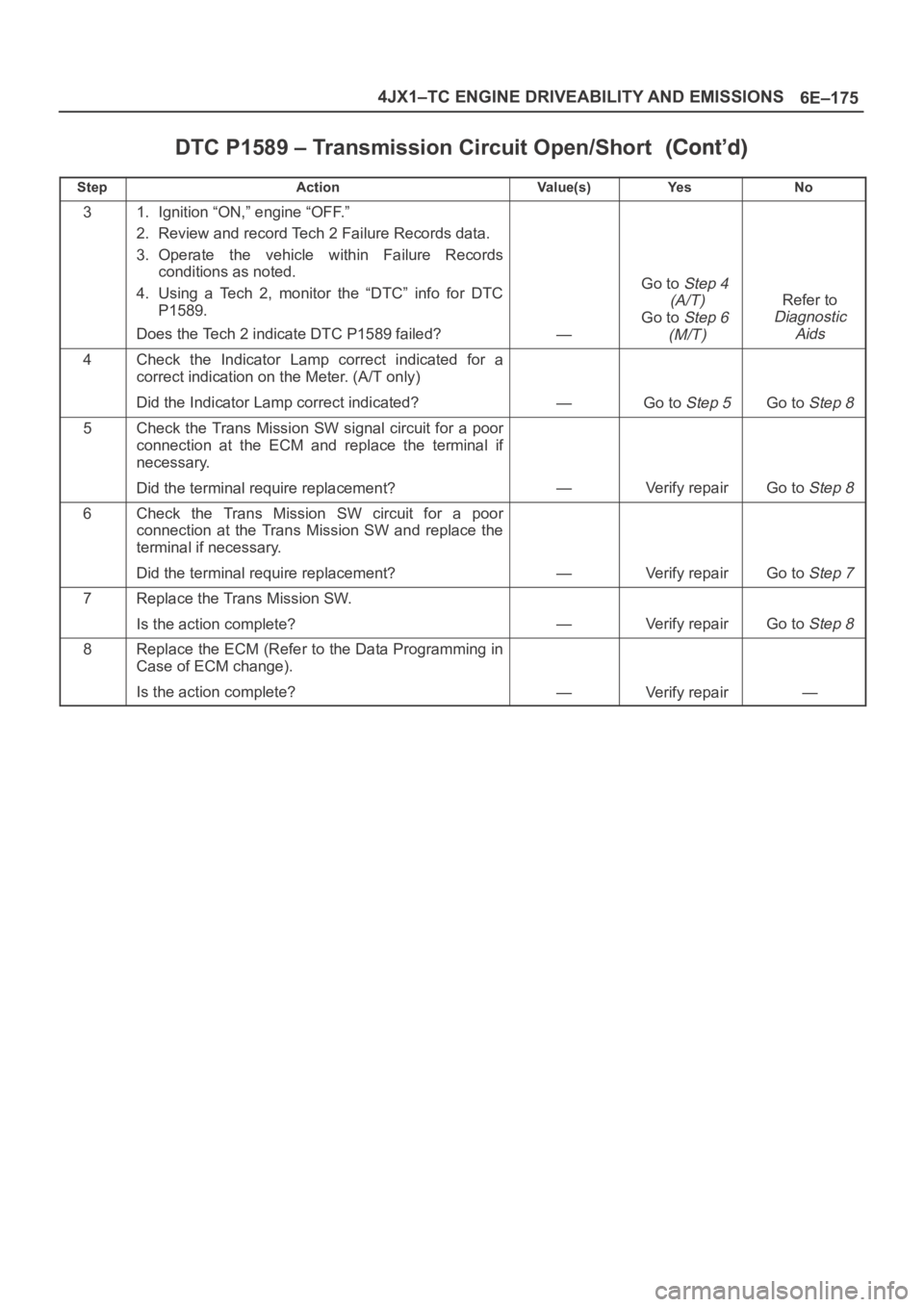
6E–175 4JX1–TC ENGINE DRIVEABILITY AND EMISSIONS
DTC P1589 – Transmission Circuit Open/Short
StepNo Ye s Va l u e ( s ) Action
31. Ignition “ON,” engine “OFF.”
2. Review and record Tech 2 Failure Records data.
3. Operate the vehicle within Failure Records
conditions as noted.
4. Using a Tech 2, monitor the “DTC” info for DTC
P1589.
Does the Tech 2 indicate DTC P1589 failed?
—
Go toStep 4
(A/T)
Go toStep 6
(M/T)
Refer to
Diagnostic
Aids
4Check the Indicator Lamp correct indicated for a
correct indication on the Meter. (A/T only)
Did the Indicator Lamp correct indicated?
—Go to Step 5Go to Step 8
5Check the Trans Mission SW signal circuit for a poor
connection at the ECM and replace the terminal if
necessary.
Did the terminal require replacement?
—Verify repairGo to Step 8
6Check the Trans Mission SW circuit for a poor
connection at the Trans Mission SW and replace the
terminal if necessary.
Did the terminal require replacement?
—Verify repairGo to Step 7
7Replace the Trans Mission SW.
Is the action complete?
—Verify repairGo to Step 8
8Replace the ECM (Refer to the Data Programming in
Case of ECM change).
Is the action complete?
—Verify repair—
Page 2069 of 6000

6E–176
4JX1–TC ENGINE DRIVEABILITY AND EMISSIONS
Symptom Diagnosis
Preliminary Checks
Before using this section, perform the “On–Board
Diagnostic (OBD) System Check” and verify all of the
following items:
The powertrain control module (ECM) and
malfunction indicator lamp (MIL) (CHECK ENGINE
lamp) are operating correctly.
There are no DTC(s) stored.
Tech–2 data is within normal operating range. Refer
to
Typical Scan Data Values.
Verify the customer complaint and locate the correct
symptom in the table of contents. Perform the
procedure included in the symptom chart.
Visual/Physical Check
Several of the symptom procedures call for a careful
visual/physical check. This can lead to correcting a
problem without further checks and can save valuable
time.
This check should include the following items:
ECM grounds for cleanliness, tightness and proper
location.
Vacuum hoses for splits, kinks, and proper
connections, as shown on the “Vehicle Emission
Control Information” label. Check thoroughly for any
type of leak or restriction.
Air intake ducts for collapsed or damaged areas.
Injector wires for cracking, hardness, and carbon
tracking.
Wiring for proper connections, pinches and cuts.
Intermittents
IMPORTANT:An intermittent problem may or may not
turn on the malfunction indicator lamp (MIL) or store a
DTC. DO NOT use the Diagnostic Trouble Code (DTC)
charts for intermittent problems. The fault must be
present to locate the problem.
Most intermittent problems are caused by faulty electrical
connections or wiring. Perform a careful visual/physical
check for the following conditions:
Poor mating of the connector halves or a terminal not
fully seated in the connector (backed out).
Improperly formed or damaged terminal.
All connector terminals in the problem circuit should
be carefully checked for proper contact tension.
Poor terminal–to–wire connection. This requires
removing the terminal from the connector body to
check.
Road test the vehicle with a Digital Multimeter
(5-8840-0285-0) connected to a suspected circuit. An
abnormal voltage when the malfunction occurs is a good
indication that there is a fault in the circuit being
monitored.
Use a scan tool to help detect intermittent conditions. The
scan tools have several features that can be used to
locate an intermittent condition. Use the following feature
to find intermittent faults:
Using a Tech–2 “Freeze Frame” buffer or “Failure
Records” buffer can aid in locating an intermittent
condition. Review and record the information in the
freeze frame or failure record associated with the
intermittent DTC being diagnosed. The vehicle can
be driven within the conditions that were present
when the DTC originally set.
To check for loss of diagnostic code memory, disconnect
the MAP sensor and idle the engine until the MIL (CHECK
ENGINE lamp) comes on. DTC P0107 should be stored
and kept in memory when the ignition is turned “OFF.” If
not, the ECM is faulty. When this test is completed, make
sure that you clear the DTC P0107 from memory.
An intermittent MIL (CHECK ENGINE lamp) with no
stored DTC may be caused by the following:
MIL (CHECK ENGINE lamp) wire to ECM shorted to
ground.
Poor ECM grounds. Refer to the ECM wiring
diagrams.
Check for improper installation of electrical options such
as lights, cellular phones, etc.
Check for an open diode across the A/C compressor
clutch and check for other open diodes (refer to wiring
diagrams in
Electrical Diagnosis).
If problem has not been found, refer to
ECM Connector
Symptom
tables.